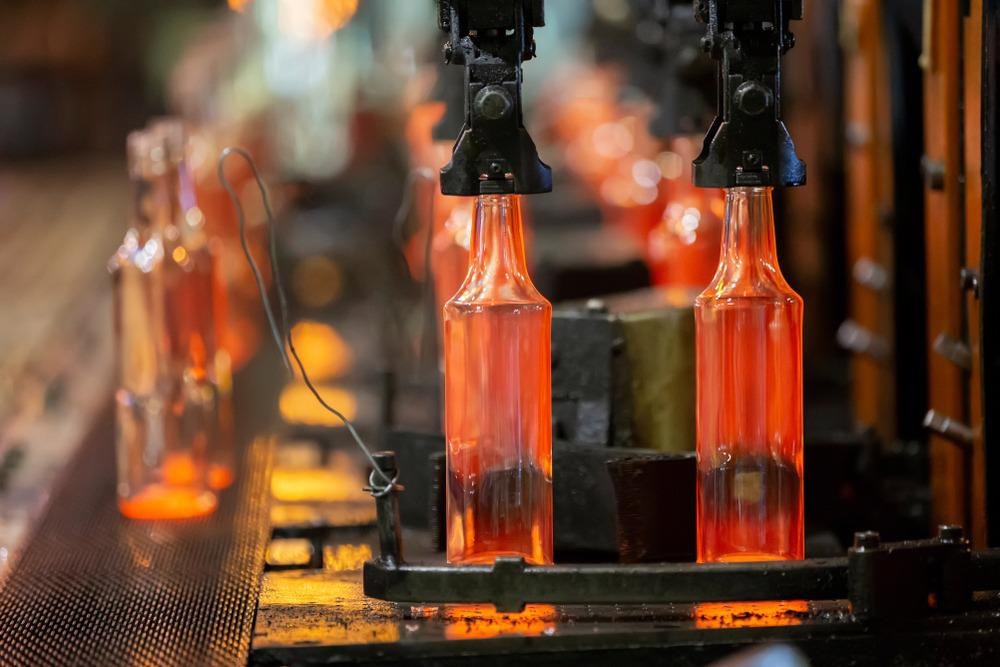Because it requires high amounts of heat, glass production is one of the most energy-demanding industries in the world. Alternatives to natural gas combustion are considered in this article.

Image Credit: SviatlanaLaza/Shutterstock.com
As with other energy-demanding processes, commercial glass production is quality sensitive, capital intensive and cost-competitive. In the past, the industry depended on fuel oil as its primary energy source, but most modern operations now use natural gas.
Massive amounts of heat are required to melt raw materials so they can be formed into glass. After the raw materials have been melted and refined, the liquid glass is formed into final products such as panes or bottles. Production of any amount of heat is based on the product being produced.
In some operations, natural gas heat is supplemented by electric heat and heat from other fuel sources, But the industry is overwhelmingly dependent on natural gas. Electric heat is used on a small scale and some production systems use electric heating methods to boost quality and productivity.
Why Relying on Natural Gas is Risky
As seen with other non-renewable energy sources, an industry being dependent on natural gas translates to a number of very serious risks.
For one, the price of natural gas can fluctuate significantly and rise sharply during times of crisis. The COVID-19 pandemic unleashed a number of factors that appeared to have driven up the price of natural gas.
On top of that, demand for natural gas has risen in Asia and gas supplies coming out of Russia have been tighter than usual.
As a result, Europeans saw their natural gas prices rise by more than 200 percent while some Asian countries saw an increase of more than 150 percent. Meanwhile, natural gas prices in the United States rose by 100 percent since the start of 2021.
There are also a number of environmental risks associated with the dependence on natural gas, as the combustion of this fossil fuel unleashes massive amounts of carbon. For example, the flat glass and container segments of the industry, which comprise around 80 percent of worldwide glass production, released approximately 18 million metric tons of carbon dioxide in 2019.
Solutions are Being Explored
There are a number of opportunities for reducing energy consumption in the glass production industry, which would translate to less natural gas combustion. For instance, improvements to the melting and refining processes could potentially reduce energy consumption by 20 to 25 percent. Improvements to other areas of commercial production could also have an impact, and these would be product-specific refinements.
While there appear to be a number of attractive possibilities, there is currently no commercially viable way to eliminate the use of natural gas in glass production.
One possible solution is the use of hydrogen gas, a renewable resource, instead of natural gas. The main issue with hydrogen combustion is that it requires more gas to achieve the same amount of heat release as natural gas. Researchers are currently investigating ways to boost the radiative qualities of hydrogen in order to make it a more viable alternative to natural gas.

Image Credit: DifferR/Shutterstock.com
Biofuels are another category of alternative fuels that could potentially replace natural gas.
Currently available biofuels produce a more radiant flame and higher heat transfer during combustion. Biodiesel is one promising type of biofuel that can be completely made from renewable sources.
While biodiesel has been used as an additive in traditional diesel fuel for the transportation industry, the glass production industry has yet to explore this option, much less a furnace completely fueled by biodiesel.
Many glass production operations are effectively using electric heat instead of heat directly produced by natural gas. Furthermore, all electric heating has been found to be far more energy efficient than natural gas heating.
Unfortunately, the complete electrification of the glass production industry requires further technological developments in furnace technology, especially when it comes to matching the capabilities of modern large capacity furnaces.
Economic viability is also a concern, as the capital expenditure costs of electrification are significant. Additional infrastructure would also likely be required.
For now, researchers are considering the possibility that hybrid systems could not only bridge the gap to a future without natural gas but could also protect an operation against spikes in material costs and supply chain issues.
For example, a gas-electric hybrid could be converted to biodiesel-electric operations or 100 percent electric heat based on need and practicality. The possible hybrid use of electricity could also lend itself to future smart grid systems.
References and Further Reading
US Department of Energy. (2021). Glass manufacturing is an energy-intensive industry mainly fueled by natural gas. [Online] Available at: https://www.eia.gov/todayinenergy/detail.php?id=12631
Sharafedin, B. et al. (2021). Soaring gas prices ripple through heavy industry, supply chains. Reuters. [Online] Available at: https://www.reuters.com/business/energy/soaring-gas-prices-ripple-through-heavy-industry-supply-chains-2021-09-22/
Zier, M. et al. (2021). A review of decarbonization options for the glass industry. Energy Conversion and Management: X. [Online] Available at: https://www.sciencedirect.com/science/article/pii/S2590174521000088
Ireson, R. et al. (2019). Alternative Fuel Switching Technologies for the Glass Sector. UK Department for Business, Energy and Industrial Strategy. [Online] Available at: https://assets.publishing.service.gov.uk/government/uploads/system/uploads/attachment_data/file/866364/Phase_2_-_Glass_Futures_-_Fuel_Switching_Tech_for_Glass_Sector.pdf
Disclaimer: The views expressed here are those of the author expressed in their private capacity and do not necessarily represent the views of AZoM.com Limited T/A AZoNetwork the owner and operator of this website. This disclaimer forms part of the Terms and conditions of use of this website.